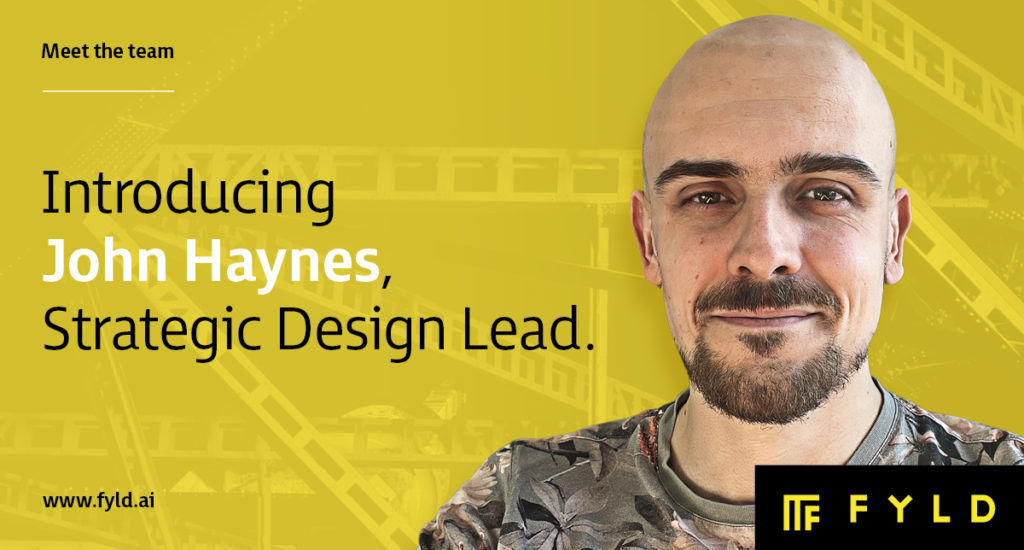Meet Strategic Design Lead, John Haynes
We caught up with our new Strategic Design Lead, John Haynes, to learn more about his expertise, what he’s passionate about delivering at FYLD and his predictions on how the future of cutting-edge technology will shape the world around us…

What attracted you to your position at FYLD and what are the key responsibilities of your role as Strategic Design Lead?
Before I was born, my dad nearly lost his leg due to an avoidable accident while working on the railway. Due to this, workplace safety is massively important to me. The ramifications of his disability have inspired me to make sure that everyone gets home safely at the end of their working day.
When I was approached by FYLD, it felt a natural fit for me. If you were to write down my dream job on paper – it’s this! It combines all the design elements I enjoy the most, along with an interesting and dynamic challenge, topped off by an exceptional team with excellent leadership. I feel very aligned to the company’s mission. It provides the perfect foundation for improving productivity and safety in the workplace.
Key responsibilities of my role are collaborating to define strategy across the business, to work with teams to deliver the agreed strategies, and also to make sure there’s time to innovate and experiment so that we continue to be a cutting-edge, future-focused company.
FYLD’s use of modern technology has rewritten best practice for undertaking risk assessments. As a designer, the chance to be involved in game-changing processes like this is an exciting prospect. Our high-performing, cross-functional teams ensure that we achieve the best of both industry and technical expertise.
What are your top priorities to deliver productivity benefits for FYLD users?
I hope to build a deep understanding of FYLD’s users by getting to the heart of their problems through qualitative and quantitative research and data analysis. I’ll then ensure to reflect this back to the business to inform our priorities going forward.
I try to think like a physicist when designing digital solutions – deconstructing their processes, removing the inefficiencies, and reconstructing them in a more efficient way.
Another priority is team alignment and implementing strategic processes. Making sure everyone is on the same page and striving for the same shared vision is key – making sure we’re always thinking of the future and how best to get there.
How do you make sure FYLD’s design strategy keeps evolving?
When scaling the business, we must be keenly aware of the current objectives while always keeping one eye on the future. Reverse engineering a design strategy is crucial within my role, but also for the wider business – working out what needs done in the future, what can be done next and what needs doing now.
Our use of modern technology provides a strong foundation upon which we can experiment and build high-tech proof of concepts for the future. We’re always aiming to be ahead of the curve when it comes to technological innovation and implementation.
How does FYLD’s recent feasibility study, enabled by the Strategic Innovation Fund grant from OFGEM, fit into the company’s goals of furthering productivity and safety benefits for its users?
We’re working with a brilliantly rich data set, and the findings so far have been incredibly encouraging. This has been a great way for me to become an expert in FYLD’s processes and vision for the future of a predictive data model. It’s clear to me that this is the future of field operations.
By improving safety, we’re making the bottom line more predictable for our customers. By being proactive, rather than reactive, we can help to mitigate costs and accidents and lower overall risk. These real time interventions at the earliest possible time benefits all parties.
How do you predict the AI and tech sectors will evolve in the coming years?
Looking to the future, democratised access to real-time information – a hive mind – will be an exciting evolution for field operatives. Every individual fieldworker will learn from everyone else. Cross pollenating information, enabling equal access and benefits, will help to continually improve and multiply data about how people make decisions, and therefore actionable results, for everyone.
The thing I’m most excited about personally is augmented reality. I believe that it’s going to be the biggest step change in technology in this fourth industrial revolution we’re experiencing. Imagine being able to assess, in real-time, the safety of a worksite – and know how to put high-risk things right. Using AI machine learning in the background, I predict augmented reality will bring forth the next industrial revolution, where safety is at forefront and workplace fatalities become a thing of the past.
To find out more, visit: https://www.fyld.ai/bespoke-solutions/















